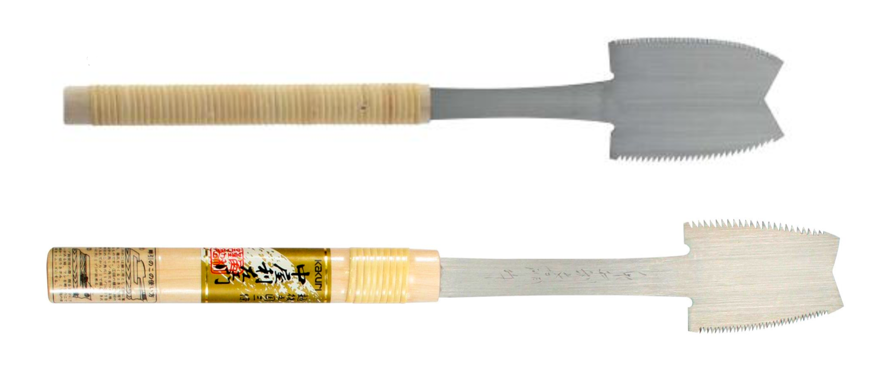So with some background on Japanese saws, which one should you choose? Like Western saws, some are better at some tasks than others, but there are likely more types of saws than in Western woodworking. Now let’s consider some of the differing types of Japanese saws. There are a number of different forms of saws, some of which are for rough cuts and dimensioning lumber, some of which are for construction, and others for fine cabinetmaking. Toshio Ōdate discusses most of these in his book. The saws described below are perhaps those most commonly used in Japanese woodworking (at least in a Western context).
First there are the Ryoba, which apart from being a style of saw, is a term used in the context of a specific genre of saws. Basically when companies describe a saw as a Ryoba, they mean a two-edged saw with one edge crosscut and the other edge rip.

These saws are suitable for everything from rough carpentry (dimensioning or re-sawing wood) to fine furniture. In many ways Ryoba saws are the equivalent of western rip and crosscut panel saws. Ryoba are generally used with two hands, and the saw is held at a steeper angle for an easy cut, of a low angle to gain more control.
Name: Ryoba - dual purpose, with two cutting edges
Style: Ryoba
Teeth: cross-cut and rip
Suitability: deep, rough cuts, dimensioning wood
Blade length: 20-36cm
The largest category of saws is likely the single-edged Kataba style saws that are not Dozuki. The blades on these saws do not have a spine, and come in various different forms, with crosscut, rip and hybrid teeth.

Name: Kataba - dual purpose, with a single cutting edge
Style: Kataba
Teeth: cross-cut and rip
Suitability: working cuts, dimensioning wood
Blade length: variable cm
The Dozuki or Douzukinoko is a single edged saw suited to fine detail work. These saws have a very thin blade which is supported by a steel or brass spine. The teeth are very fine (typically 24 tpi), and have very little set, and the saw leaves an incredibly smooth surface. One limitation of course is that the depth of cut is limited by the spine. Most are crosscut, but Dozuki rip saws exist as well.

Name: Dozuki - very thin blade + spine
Style: Kabata
Teeth: cross-cut and rip
Suitability: tenon shoulders, dovetails, precision cuts
Blade length: 20-28cm
There is one issue in that the saw typically used by Westerners to cut dovetails is the Dozuki which is a cross-cut saw, however cutting dovetails is a ripping operation.
The Azebiki can be single or double-sided, and has a curved blade that allows a cut to be started or stopped in the middle of a board. The blade is usually quite short, and therefore requires a guide block. These saws are exceptional for cutting things like sliding dovetails.

Name: Azebiki - short blade, curved edges + long neck
Style: Kabata and ryoba
Teeth: cross-cut or rip
Suitability: starting centred cuts, sliding dovetail joints
Blade length: short
The Kugihiki is a flush cut saw used for dowels or trim.

Name: Kugihiki - flexible blade, no teeth set
Style: Kabata and ryoba
Teeth: cross-cut
Suitability: flush cutting dowels
Blade length: 18-20cm
Anahiki saws typically have a curved blade. Prior to industrial times, saws with curved blades were quite common, which is likely because the back and forth movement of the human arm tends to trace a curve rather than a straight line and this curve will be followed by a saw. Today it is easier to produce straight lines rather than curved ones, so they have fallen out of favour.

Name: Anahiki - long blade, rough work
Style: Mostly kabata
Teeth: cross-cut
Suitability: large timbers and beams
Blade length: 31-46cm
A commonly overlooked but very useful saw is the Mawashibiki, keyhole saw for cutting a curved or circular hole. The blade is usually tapered from front to back and top to bottom. The blade is typically made of softer steel to allow for more flexibility.
Name: Mawashibiki - keyhole saw, long, narrow blade
Style: Kabata
Teeth: any
Suitability: cutting curves
Blade length: 31-46cm

The ryoba has become my favorite once I figured out how to best use the rip side. The right cutting angle is key and depends on what kind of wood one is sawing.
The azebiki has become another much-used saw for me. A guide block – as you pointed out – is very helpful. Occasionally I just use a deeply scored knife line to guide the cut.
Alfred
I think the true benefits of Japanese saws is that they provide solutions to things that Western saws cannot. A good example is the flush-cutting saw, or for extremely fine cuts, something western saws have never been able to master.